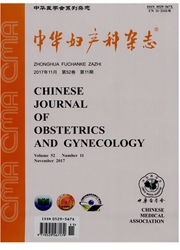

 中文摘要:
中文摘要:
目的探讨卵巢上皮性包涵体的起源与低级别卵巢浆液性癌的发病机制。方法收集山东大学齐鲁医院和美国亚利桑那大学附属医院病理科自2000年5月至2010年4月间收治的卵巢浆液性肿瘤患者及行预防性附件切除术患者的手术标本共198份。其中,卵巢肿瘤标本138份,包括卵巢浆液性囊腺瘤53份、卵巢交界性浆液性肿瘤44份、低级别卵巢浆液性癌41份;无明显病理学变化的同侧卵巢及输卵管标本116份(卵巢及输卵管分别为60、56份),取自60例行预防性附件切除术患者的一侧附件。HE染色后镜下观察所有标本的病理学形态特点;并采用免疫组化单染色法检测其免疫表型配对盒基因8抗原(PAX8)、钙结合蛋白(calretinin)、微管蛋白(tubulin)、核增殖相关抗原(Ki-67)的表达,免疫组化双染色法检测其免疫表型PAX8/calretinin的表达。结果免疫组化PAX8、calretinin单染色法检测显示,90%(54/60)的卵巢表面生发上皮细胞的免疫表型为PAX8阴性(-)、calretinin阳性(+),HE染色后镜下观察符合间皮组织的形态特点,为间皮型上皮;但有10%(6/60)的卵巢表面生发上皮细胞的免疫表型为PAX8(+)、calretinin(-),HE染色后镜下观察其与输卵管上皮组织的形态相似,为输卵管型上皮。60份正常卵巢中共有921个卵巢上皮性包涵体,表现出两种免疫表型,79%(728/921)为PAX8(+)、calretinin(-),HE染色后镜下观察其与输卵管上皮组织的形态相似,为输卵管型包涵体;21%(193/921)为PAX8(-)、calretinin(+),HE染色后镜下观察其与间皮组织的形态相似,为间皮型包涵体。免疫组化PAX8/calretinin双染色法进一步验证了卵巢上皮性包涵体的这两种免疫表型。免疫组化PAX8、calretinin、tubulin单染色法检测显示,免疫表型为PAX8(+)、calretinin(-)、tubulin(+
 英文摘要:
英文摘要:
Objective To investigate the possible origin of ovarian epithelial inclusions and itsrelationship with the low-grade ovarian serous carcinoma. Methods By comparatively evaluating the morphologic (secretory and ciliated cell distribution) and immunophenotypic [ using paired box gene 8 (PAX8), tubulin, calretinin, and Ki-67 as first antibodies ] attributes of ovarian epithelial inclusions, the normal tubal epithelium, and the ovarian tumors, all adnexal tissues from a total of 198 patients weres studied, including 116 adnexae removed for non-neoplastic indications, 53 serous cystadenomas, 44 serous borderline tumors, and 41 low-grade serous carcinomas, which were collected from Qilu Hospital of Shandong University and University of Arizona in USA. Immunohistochemical single staining was used to detect the expressions of PAX8, tubulin, calretinin, and Ki-67 in the two groups, while immunohistochemical double staining of PAX8/calretinin was used to figure out the immunophenotype of various ovarian epithelial inclusions in a more intuitive way. Results With immunohistochemical single staining of PAX8 and calretinin, the vast majority (90% ,54/60) of ovarian surface epithelia displayed a mesothelial phenotype [ calretinin ( + ), PAX8 ( - ) ], whereas 10% (6/60) of the cases displayed foci with tubal phenotype [ calretinin( - ), PAX8 ( + ) ]. In contrast, most ( 79%, 728/921 ) of the ovarian epithelial inclusions displayed a tubal phenotype, though 21% (193/921) of the ovarian epithelial inclusions showed a mesothelial phenotype. It was further proved by immunohistochemical double staining of PAX8/ calretinin. Secretory and ciliated cells were found in the ovarian epithelial inclusions with tubal phenotype. There was a progressive increase in the secretory/ciliated cells ratio and proliferative index, from ovarian epithelial inclusions/cystadenomas to borderline tumors to low-grade serous carcinoma, according to the expression of tubulin and Ki-67. Conclusions The findings mak
 同期刊论文项目
同期刊论文项目
 同项目期刊论文
同项目期刊论文
 Intraperitoneal photodynamic therapy for an ovarian cancer ascite model in Fischer 344 rat using hem
Intraperitoneal photodynamic therapy for an ovarian cancer ascite model in Fischer 344 rat using hem 期刊信息
期刊信息
